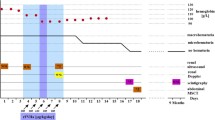Abstract
Recombinant factor VIIa (rFVIIa, NovoSeven) has been registered for the treatment of bleeding episodes in patients with inherited or acquired hemophilia A or B with inhibitors. Furthermore, rFVIIa has been used successfully for the treatment of bleeding in patients with thrombocytopenia, and acquired and congenital platelet dysfunction. The definite spectrum of indications for rFVIIa has not yet been established. We describe a case of severe intra-abdominal bleeding 3 days after non-heart beating kidney transplantation in a patient with severe coronary artery disease in which rFVIIa (a single intravenous bolus injection 70 μg/kg bodyweight) was successfully used. No thrombotic complications occurred. This report demonstrates that rFVIIa might be safe and effective after recent renal transplantation.
Similar content being viewed by others
References
Hedner U (2001) Recombinant factor VIIa (Novoseven) as a hemostatic agent. Semin Hematol 38:43–47
Palestini M, Randone B, Bianchi G, Ponzio F, Carmellini M, Citterio F, Bretto P, Boggi U, Castagneto M, Cavallaro A (2000) Donor and recipient postoperative complications in living related kidney transplantation. A multicentric study. Minerva Chir 55:709–712
Malyszko JS, Malyszko J, Mysliwiec M (1999) Tissue factor and tissue factor pathway inhibitor in kidney allograft recipients. Transplant Proc 31:2118–2120
Schmidt RH, Lenz T, Grone HJ, Geiger H, Scheuermann EH (1999) Haemolytic-uraemic syndrome after tacrolimus rescue therapy for cortisone-resistant rejection. Nephrol Dial Transplant 14:979–983
Burke GW, Ciancio G, Cirocco R, Markou M, Olson L, Contreras N, Roth D, Esquenazi V, Tzakis A, Miller J (1999) Microangiopathy in kidney and simultaneous pancreas/kidney recipients treated with tacrolimus: evidence of endothelin and cytokine involvement. Transplantation 68:1336–1342
Finn WF (1999) FK506 nephrotoxicity. Ren Fail 21:319–329
Chandler WL, Jelacic S, Boster DR, Ciol MA, Williams GD, Watkins SL, Igarashi T, Tarr PI (2002) Prothrombotic coagulation abnormalities preceding the hemolytic-uremic syndrome. N Engl J Med 346:23–32
Hendriks HG, Meijer K, de Wolf JT, Klompmaker IJ, Porte RJ, de Kam PJ, Hagenaars AJ, Melsen T, Slooff MJ, van der Meer J (2001) Reduced transfusion requirements by recombinant factor VIIa in orthotopic liver transplantation: a pilot study. Transplantation 71:402–405
Nakamura K, Yoshimura N, Sano H, Kobayashi Y, Ushigome H, Oka T (1998) Role of tissue factor in ischemia-reperfusion injury: immunohistochemical assessment of tissue factor pathway inhibitor staining of the liver. Transplant Proc 30:3737–3739
Sanchez Bueno F, Hernandez Q, Ramirez P, Robles R, Acosta F, Rodriguez JM, Parrilla P (1999) Vascular complications in a series of 300 orthotopic liver transplants. Transplant Proc 31:2409–2410
Roberts HR (2001) Recombinant factor VIIa (Novoseven) and the safety of treatment. Semin Hematol 38[Suppl 12]:48–50
Bajaj MS, Bajaj SP (1997) Tissue factor pathway inhibitor: potential therapeutic applications. Thromb Haemost 78:471–477
Golino P, Ragni M, Cirillo P, Scognamiglio A, Ravera A, Buono C, Guarino A, Piro O, Lambiase C, Botticella F, Ezban M, Condorelli M, Chiariello M (2000) Recombinant human, active site-blocked factor VIIa reduces infarct size and no-reflow phenomenon in rabbits. Am J Physiol Heart Circ Physiol 278:H1507–1516
Peerlinck K, Vermylen J (1999) Acute myocardial infarction following administration of recombinant activated factor VII (NovoSeven) in a patient with haemophilia A and inhibitor. Thromb Haemost 82:1775–1776
Acknowledgements
The authors wish to thank Prof. Dr. J.P. van Hooff, Department of Nephrology, and Dr. E.C.M. van Pampus, Department of Hematology, University Hospital Maastricht, for their critical comments on the manuscript
Author information
Authors and Affiliations
Corresponding author
Rights and permissions
About this article
Cite this article
Gielen-Wijffels, S.E.M.J., van Mook, W.N.K.A., van der Geest, S. et al. Successful treatment of severe bleeding with recombinant factor VIIa after kidney transplantation. Intensive Care Med 30, 1232–1234 (2004). https://doi.org/10.1007/s00134-004-2181-0
Received:
Accepted:
Published:
Issue Date:
DOI: https://doi.org/10.1007/s00134-004-2181-0




